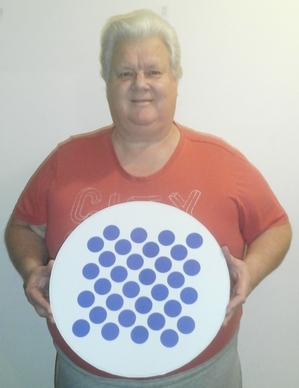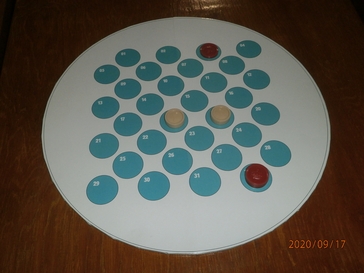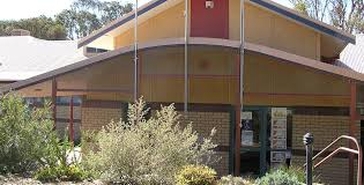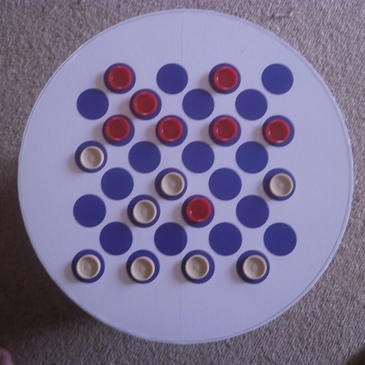Rebooting Checkers

Checkers is in need of a reboot. That's the opinion of Australian Richard Torning, and he has some original ideas about how to go about it.

Richard Torning and "Roundsquare" Board
We can't argue with Mr. Torning's major premise. The fortunes of our game of checkers have been declining since the 1950s, when television became a big thing. You've heard it all before, about how the public considers checkers a game for kids and old men; that someone is playing "checkers" instead of "chess" when they need to up their game and move to a higher level; and the list goes on.
Mr. Torning wants to make the game more appealing, and to do so he's revived and modernized an idea that actually goes back more than 100 years but never really caught on: the "roundsquare" board. But instead of trying to fit a square peg into a round hole (or vice-versa), he's instead "circling the square" and the new board is just one part of a multi-pronged approach.

Numbered "Roundsquare" Board
We did an an-depth interview with Mr. Torning. You can read it all by clicking on Read More, just below the problem solution (please solve the problem first!), and we think you should. Mr. Torning has an insightful and appealing message for us. Not for him is yet another "modern" variant of the game that inevitably detracts rather than adds. His ideas are practical and cogent.
For one thing, he'd like to see a fresh start with the game renamed, and the name depending upon the language and usage of a particular area. He suggests Checkers-32 in the United States, Draughts-32 elsewhere in the English-speaking world, and so on, even going so far as to suggest a series of meaningful names to use among Aboriginal groups in Australia.
Of the "roundsquare" board, he says this: "The aim is to keep a minimalist approach to the game by further eliminating the 32 superfluous squares on the board but retaining the rules and shape of the two pieces. Instead of limiting the game to red/white or black/red pieces there is a need to make the game colorful, attractive, eye-catching, and simple to understand."
Mr. Torning's prototype boards are indeed very colorful and attractive and instantly attract attention. He also points out that using this board would uniquely differentiate our version of checkers from all others, and especially distance the game from chess.
Again, we urge you to read Mr. Torning's full remarks. He has also provided an interesting booklet, Early Australian Draughts Games, which you can download here.
The Draughts-32 idea is currently being prototyped at Minimbah Aboriginal School in Australia. Mr. Torning hopes to spread it far and wide and asks for your support by trying out the new board and the new ideas in your own checker playing community, and then becoming an ambassador.

Building at Minimbah School
We can only wish Mr. Torning much success. Surely we would all like to see checkers have a vibrant and exciting future. Mr. Torning is working to make that happen.
And now, to "round" out today's column and "square" all accounts, here's a checker problem presented on a roundsquare board.
BLACK

WHITE
White to Play and Win
W:W13,18,20,22,29,30,31,32:B1,3,6,9,10,11,12,23
See if you can get "round" to solving it, after which you can "square"-ly click your mouse on Read More to see the solution.![]()
Solution
Solution and lettered notes are by the problem author. Numbered notes are by your Editor, using the KingsRow computer engine.
31-26 23-27---B 32-23 10-14---A 22-17!---1 14-21 23-19 White Wins.
A---12-16, 29-25, 10-15---C or 3-7 or 3-8, or 1-5 loses by 23-19.
B---10-14 26-19 14-23 22-18, White Wins.
C---10-14 22-17 14-21 23-19 16-23 26-19 3-7 19-16 6-10 13-6 10-15 25-22 1-10 16-12 White Wins.
1---Both 30-25 and 29-25 only draw. Try it! Black ties up the White pieces and eventually wins one back.
Checker Maven Interview with Richard Torning
December, 2020
1. What led you to the idea of "rebranding" draughts/checkers?
Firstly, congratulations on a great website - Checker Maven is a must to read! I built my own quality library from reading your book reviews and the recommendations of GM Richard Pask.
Checkers or Draughts? It is confusing – there is no right or wrong answer. Unfortunately, there is no consistency in these two terms. Both names have negative connotations these days depending upon the continents on which these words are used.
The rebranding concept emerged whilst I was researching to produce a book for the 50th Jubilee of the New South Wales Junior Chess League (NSWJCL) for 2023. In addition to the chess material I was continually finding references to draughts. These references ceased around the mid-1950s, although one ‘last hurrah’ was attempted in 1965. I possess most of the Austral Chess and Draughts Newsletters from the 1922-1928 period. Even back then there were no junior draughts tournaments in Australia. There was an odd reference here or there to a school having a draughts competition. The last remnants of activity were found in the newspaper columns which ceased around 1970. Draughts had virtually died out as a serious tournament sport by the time I was born (1960).
The more research I did for the chess book the more I realised that there was a massive gulf in the status of draughts compared to chess. I also thought that the unfair comparisons made between these games were propounded by chess players often with arrogant, ignorant, and ill-informed opinions.
The deeper I researched the more I realised that Australia’s rich period of draughts activity occurred between the 1870s-1930s. I then explored reasons why chess had thrived, and draughts had ‘died’ during my lifetime. I comment on these issues in the booklet and provide some random games from that period.
Being of Aboriginal descent my research uncovered two significant draughts players who were indigenous. The booklet introduces Womby and Jacob Harris to the world! Indeed, these two heroes were the spark that led me to consider how the image of the Australian Aboriginal community could benefit from draughts again. My original intention was to introduce the new board to Aboriginal schools in Australia. However, it deserves a wider audience. I still intend to start the program within the Aboriginal communities. Anecdotally I can state that very few children who identify as Aboriginal play chess.
In Australia, draughts eventually became colloquially referred to as checkers. The status of the game was reduced to being slightly higher than tic-tac-toe and much easier than chess. In short, very few take draughts seriously anymore in Australia.
It occurred to me that significant rebranding was probably the only way to resurrect this great game. I gathered a group of family and friends to get involved with constructive ideas; we formed an ad hoc steering committee in late 2019 and continued discussions during the COVID19 isolations of 2020. The ideas contained in the booklet are the result of brainstorming sessions and research, especially with staff at the Minimbah Aboriginal School in Armidale, New South Wales.
2. How does the "roundsquare" board help with rebranding?
Whilst thinking about how to introduce draughts to the Aboriginal communities I came across William Call’s ‘roundsquare’ board in his Vocabulary of Checkers 1909 book. Call’s idea never gained popularity. Circles are a significant part of Aboriginal artwork. In order to encourage ownership, we came up with the idea that the children could create their own boards with circles incorporating cultural images and totems such as: echidna, kangaroo, wombat, emu, koala, goanna, snake, platypus, boomerang, spear. This remains the steering committee’s main objective.
Making a template available online, which could be downloaded by teachers or individuals, would assist in linking draughts with art and culture. The students would be encouraged to produce their own boards with whatever social or cultural motifs were significant to them. This is also an important social talking point. If two players meet, the design of their boards and pieces may reflect different cultural backgrounds. This would enable the players to discuss the motifs on their boards and pieces and learn a little bit about another culture.
We have eliminated any reference to square. It is a round-board, and I prefer to call it Draughts-32 (or 32) as a proto-type name for the rebranding. The Aboriginal names we have also considered include: Ngara, Wingara (both have meanings emphasising thinking) or Bunilbanga (take off). The new image is for 32mm round playing discs to sit on 32 round bases on a round board.
Our emphasis for a world-wide audience is to enable our noble game to be adapted to and played by every ethnic or social group. This concept is highly original and capable of easy adaptation. The name of the game could be Draughts-32 in Australia, Checkers-32 in the USA, Ngara-32 amongst the Darug Aboriginal community in Sydney, Yabiyaliga-32 for the Ngarigo people of Canberra, or Anēwan-32 for the people of Armidale. Basically, each ethnic or social group can name their version (insert name)-32! We would still have the same board and rules!
The aim is to keep a minimalist approach to the game by further eliminating the 32 superfluous squares on the board but retaining the rules and shape of the two pieces. Instead of limiting the game to red/white or black/red pieces there is a need to make the game colourful, attractive, eye-catching, and simple to understand. At the same time, we will be able to completely differentiate Draughts-32 from other checkers variants (such as the so-called International Draughts) and more importantly from Chess.
This is a unique opportunity for the draughts and checkers community to become leaders by reinvigorating the game throughout the world. The FMJD (World Draughts Federation) want Checkers 10x10 to be the norm – we want Draughts-32 to be the flagship standard-bearer, and not treated simply as a springboard to a completely different version of a square boarded game.
I do not believe that the current experts, masters, or grandmasters would be disadvantaged by the new image or playing board.
3. The round board is not a new thing, but your presentation is. Can you tell us more about the updated design and how it fits into the campaign?
The objective was to eliminate all comparisons with chess and minimise comparisons with other namesakes (10x10 checkers, Polish checkers, Russian checkers, Pool checkers etc…). The most notable being the current 64 square board. Using the word ‘roundsquare’ keeps the link to chess by using the term square. Also, Call’s original intent was to confine it to a square perimeter and reduce the size of the board. We have eliminated all squares by the new design and are encouraging the game to be included as part of holistic school learning.
The first stage was to develop software for a diagram maker to see if the idea was visually appealing. This enabled the Draughts-32 concept to be understood by a wider audience.
The Draughts-32 board is round, and the playing field comprises only the 32 playing circles which we call bases. There is nothing square about the look. The new board reduces the eyesight from having to take in 64 squares by eliminating the other 32 non-playing and superfluous squares completely!
The Draughts-32 board only has the bases numbered 1-32. The reason for numbering the board is to help juniors and new players to record their games and make access to literature more user friendly. The game should be enjoyable to learn and not a chore. The numbers can be included on the board or left off completely, depending upon personal preference.
Chess with the enticement of the beautiful Staunton designed pieces is a very attractive game. The power and movement of the 6 different chessmen also adds a degree of mystery. However, chess could be said to be stuck in the pre-talking Black and White era like the movies. Whilst that is a bit of hyperbole, the point is chess too has had to reinvent itself recently with Chess 960.
Let us rejoice with the vibrancy of Draughts-32. A collage of colour across a tournament hall with an array of coloured boards and discs on those boards! I suggest we all think outside the box and find ways to invigorate tournament participation! Dave Battese, Minimbah Aboriginal School in Armidale, has suggested the boards be painted by the students as a creative arts activity then lacquered. This would enable two different designs either side the one board.
Our purpose is to give the game an image lift through a new name and logo, whilst retaining the rules and notation for recording games. A slight adjustment to accommodate gender-neutral nomenclature is discussed in the booklet. Margaret Sharpe BSc (hons) PhD, suggested that the Kingsrow be referred to as the initiation rank for indigenous communities and the pieces become, not kings, but elders.
Draughts-32 offers an appealing alternative to the current standard. One hundred years ago it was proudly referred to as SCIENTIFIC! Indeed, it is, however there is a need to complement this advanced scientific depth of calculation by supporting the minimalist allures ie: 32 playing bases, movement and power of only two pieces/discs, fewer openings to learn and less rules. One simple rule still applies – if you cannot move, you lose!
4. What are your plans for publicizing your effort?
Our original intention was to introduce it locally in my home State – New South Wales.
The Minimbah Aboriginal School in Armidale, New South Wales, are part of the steering committee and are endorsing the project as part of their teaching program at school for children aged 5-12 years of age. The Principal, Jenny Brown, is encouraging the wider Aboriginal community to get involved with the program.
I noticed that the game is referred to as Draughts in Europe and Checkers in the USA. I did not want to get into a name fight. I consulted with GM Richard Pask, who replied as follows: “Draughts or checkers: use whichever name the public is the least familiar with!” The rationale being that great damage has been done to the brand on all continents, mistaking the game as “easy for kids or old folk”, regardless of the name used.
We are progressing with our Draughts-32 plan. We have produced Draughts-32 diagram software to create lessons. There will be a website. We are developing a logo. We intend to run coaching activities and tournaments. COVID19 has slowed the access to schools and juniors this year, however, Minimbah Aboriginal School are coming up with some wonderful ideas that extend Draughts-32 from being a simple board game into an holistic learning approach as part subjects such as: cultural studies, arts and crafts, linguistics, mathematics, history, sport, communications and social studies, but with an emphasis on fun!
5. You compare chess, which is widely respected, with draughts/checkers, which is viewed differently by the public. How can your campaign help elevate draughts/checkers?
This is a new era. The Draughts-32 product moves in a new direction by positively emphasising:
(a) cultural inclusivity by enabling the board and discs to be designed to adapt to every ethnic or social group, (such as the Aboriginal communities in Australia)
(b) the new playing board,
(c) a new name/logo to avoid ill-informed comparisons with chess and other checkers variants,
(d) lots of bright colours on the board and a wider variety of colourful playing discs,
(e) step-by-step instructions to make your own playing board cheaply as an art activity,
(f) Draughts-32 as a school learning activity linked to art, mathematics, problem solving, critical thinking, language, social science and history,
(g) concentration, visualisation, pattern recognition and memory recall skills,
(h) social skill development,
(i) the minimalist nature of the game and simplicity of the rules, with hidden gems and beauty awaiting to be discovered,
(j) an alternative game for those who are not inclined to play chess,
(k) the game as being girl friendly,
(l) inclusiveness of the game/sport for people with special needs or different abilities,
(m) the merits of Daughts-32 as a bonding activity for parents/guardians with juniors,
(n) an activity that will reduce juniors’ time on screens (TV, computer, ipad),
(o) a new pathway for players to become coaches and administrators,
(p) Draughts-32 as a lifetime hobby,
(q) promotion of junior tournaments,
(r) problem solving competitions,
(s) promotion of Draughts-32 in newspaper columns, church newsletters, school newsletters, shopping centre bulletin boards,
(t) attracting sponsors to local clubs or tournaments,
(u) Draughts-32 by excluding any association with chess from our clubs,
(v) the production of video lessons online,
(w) the discussion on the benefits of draughts,
(x) promotion of the status of Grandmasters such as Pask, Moiseyev, Scarpetta, King, Kondlo, et al,
(y) Draughts-32 as the ultimate no chance, no dice, no cards game,
(z) Draughts-32 as the ultimate intellectual game of ‘tug-o-war’ (Fortman).
The effect of positively promoting Draughts-32 with a new round image will indirectly inform the public of its distinction from chess and other draughts variants.
Equation: different board + different rules + different pieces = different game/sport/art/science!
This may dissuade any nexus between chess and draughts/checkers.
6. How do you think the campaign will play out? What are your thoughts about the future of draughts/checkers?
I am extremely positive that Draughts-32 is here to stay. It just needs a bit of momentum. I started up the longest running radio program for fathers, DADS ON THE AIR in 2000, which continues under other people today. Internal motivation is a key factor in driving any project. Our motivation is to raise up the next generation to keep juniors involved and learning so that when they reach maturity, they in turn will continue to promote the game to future generations. We are two generations behind in Australia at present.
Our paradigm is an extension to what already exists. We are seeking ways to gain a footprint into every home or school in every culture on the planet. I think we have an ideal and universal product to enable this to happen! In time we may see the 64 square version become obsolete.
This is a concept. As the concept matures ideas will emerge to support the growth and evolution of the game. I am convinced that Draughts-32 will be able to produce coaches and administrators to ensure its longevity.
The pilot project starting at Minimbah Aboriginal School, Armidale, New South Wales, will be our first opportunity to measure the merits of the concept.
7. How can draughts/checkers enthusiasts around the world assist with your campaign?
We are Draughts-32 or ‘32 in embryo!’ Do you like the name 32 or Draughts-32, or any of the previous suggestions? There needs to be some way of unifying the terms checkers and draughts. Chess is just Chess.
Start up your own Draughts-32 group, or help others by:
sourcing and providing unpainted wooden discs,
finding someone that makes generic round vinyl boards,
donating 40cm diameter cake-boards that are say 5mm deep to that group.
Constructive feedback is usually the most crucial form of assistance. However, our steering committee is not the peak body and we have enough to do promoting the game locally. If the English Draughts Association, Scottish Draughts Association, American Checkers Federation etc… form a combined peak body as Draughts-32 they may be able to unite. (I am not sure the FMJD or IDF want our form of the game to be the No.1 flagship brand.)
In fact, this concept sets us apart from all other variants of the game.
With the new board there will no longer be any ‘rank and file’ players – we could now refer to these people as “ringers”. Get involved – start coaching juniors the basics. Use GM Pask’s material. Run local tournaments for children. Make Draughts FUN to LEARN! Our motto is THINKERS LEARN DRAUGHTS-32!
8. Is there anything else you'd like to add or bring to the attention of our readers?
More explanation is available in the accompanying booklet and I would encourage people to read it. It expounds the reasons for rebranding and storytelling. It also illustrates the concept with colorful visual diagrams.
Anyone with a checkers or draughts book, no matter how old, will not be disadvantaged. Unlike chess which changed its notation from descriptive to algebraic in the 1960s-1970s we are not changing our numbering system at all. It will be firmly embedded as 1-32. What changes is the playing field – but the game patterns are the same on either board (square or round).
There will be the ‘nay-sayers’ who are comfortable with the game as it is, those who do not want any change or are oblivious to the need for change. To them I would ask “What have you done to promote the game as it stands now?” and “How successful has that been for you and the game?” If it “ain’t” broke don’t touch it. Well it is broke! Whilst conversation acts as a discussion generator, we intend to take action and not just let it degenerate into another talkfest.
Draughts-32 is here to stay. It is already starting at Minimbah Aboriginal School!
You can email the Webmaster with comments on this article.